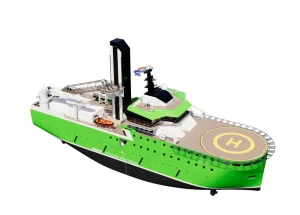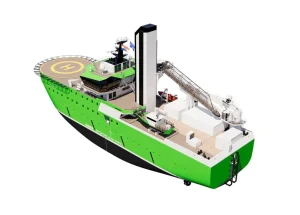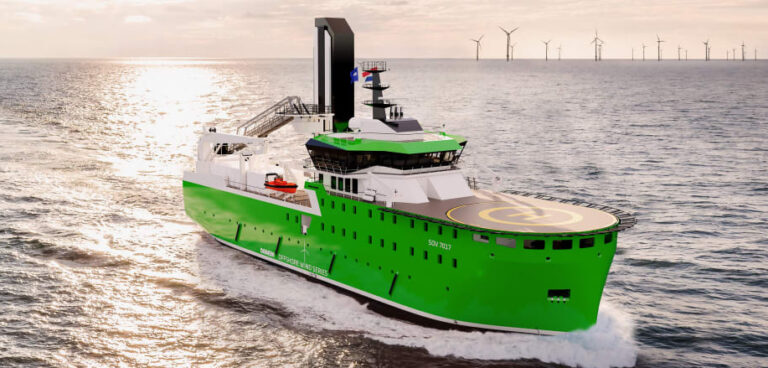Damen has begun plans to introduce a fully electric service operations vessel (SOV) for offshore wind farms.
With continuously growing energy demands, the need for renewable offshore wind energy is also on the rise. Currently, wind farms are maintained by technicians using service operations vessels (SOVs) which serve as warehouses, workshops, transportation and accommodation for all the technicians on board. In the areas where green energy is generated, these SOVs emit CO2, even though significant efforts are being made to reduce emissions and enhance vessel efficiency.
Damen’s proposed electric SOV for offshore wind support operations has been named the SOV E and will reportedly be the first large offshore vessel to operate fully electrically.
The electric SOV is for operations within wind farms and will be equipped with charging capabilities that will access electricity from suitably equipped turbines and offshore substations. It will charge similar to the way that electric cars charge today. The premise that underlies the SOV E as an emission-free vessel is that it will recharge its batteries once a day. This is feasible due to the nature of its operational profile, where it deploys technicians to the wind turbines and then loiters nearby until it is time to retrieve them. It will therefore generally have idling time in each 24-hour period, which can be used for recharging the vessel, using just a small part of the energy generated by the wind farm.

 While the SOV E is capable of sailing entirely electrically, it will be equipped with diesel generators as backup. These will not only enable it to undertake alternative duties at any point in the future, they will also increase the operational flexibility of the vessel.
While the SOV E is capable of sailing entirely electrically, it will be equipped with diesel generators as backup. These will not only enable it to undertake alternative duties at any point in the future, they will also increase the operational flexibility of the vessel.
Research is also being undertaken to ensure that an emergency release is available in the event of an immediate evacuation being required. The location for integrating this connection on the vessel has been carefully chosen to avoid compromising the large open deck area while benefiting from stable dynamic positioning (DP) capabilities. One of the aspects being studied is the chemical compounds of the batteries, the raw materials used to produce them and their recyclability.
The differences in investment between the SOV E and the conventional diesel-electric SOV are being identified, including the additional investment required for charger systems within the wind park. The operational costs of the SOV E is expected to be substantially lower than those of a conventional SOV, taking into account the fuel price and the price per ton of CO2. Various scenarios have been evaluated, all yielding positive business case results. As the cost of CO2 emissions continues to rise, the financial outlook becomes even more promising.
To bring this concept to life, the company plans to enable a high level of integration between wind farm operators, vessel owners, charging systems designers and Damen through partnerships. The partners will aim to create a vessel that can not only remain in wind farms for extended periods of time, but also take full advantage of the abundant clean energy available locally to reduce emissions to virtually zero.
To find out more about Damen’s latest developments in the electric and hybrid marine technology industry, click here.



